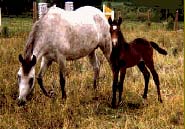New Forest Pony
N/A
Sat, 19th April, 2025 - 2:27 pm GMT
Sponsor Ads:

Alternative Name
N/ABasic Info
New Forest Ponies range in size from 12 hh to 14.2 hh, and although there is no official lower limit, they seldom go below 12hh. The most prominent colors are bay, brown and gray followed by chestnuts, roans and blacks. Limited white markings are allowed on the head and legs. Blue-eyed creams, piebalds and skewbalds are not permitted. The New Forester displays free, straight movement, plenty of bone, strong rear quarters, good depth of body and should be of riding type, with a good deal of substance. The head should be of "pony type;" the shoulders should be long and sloping; the quarters should be strong and well muscled; the body is deep; the legs are straight with strong joints and good hard hooves. The larger ponies, while narrow enough for children, are capable of carrying adults. The smaller ponies, although not up to so much weight, usually show more quality than the larger animals.
Health
N/AHabitat
N/ABehavior
New Forest ponies combine the characteristics of the other native British ponies such as strength, intelligence and agility with a narrower build, tractable temperament and speed. It is a recognized breed of the mountain and moorland ponies of the British Isles. Not only was the breed influenced by native British stock but also the various infusions of blood from horses that crossed Britian during various periods of history. Presently there are flourishing studs of registered New Forest ponies not only in the United Kingdom but throughout Europe, Canada and Australia. Most New Forest ponies are good jumpers and are naturally good at gymkhana events and mounted games. They make excellent harness ponies. New Forest ponies have been successfully trained for dressage, polo, long-distance riding, cross-country events and carrying the disables. They have long been raced locally and are surprisingly fast, especially over rough terrain. The New Forest Pony is considered an ideal mount for families seeking a horse appropriate for both children and adults and one that is skilled in adapting to the various skill levels of various riders.Origin
Southwest HampshireHistory
The New Forest Pony gets its name from the New Forest that lies along the English coast between Southampton and Bournemouth in southwest Hampshire. This region comprises one of the largest areas of unenclosed land in southern England and today is a popular recreational destination for the general public. The New Forest ponies still roam its heaths, woodland and bogs as they have for centuries. It is, however, unknown as to how or when these fine ponies passed into private ownership. It was not until the end of the nineteenth century that systematic efforts were made to improve the breed. In 1891, the Society for the Improvement of New Forest Ponies was founded. In 1906, the Burley and District New Forest Pony and Cattle Breeding Society started to register mares and young stock, and the first studbook was published in 1910. At that time stallions from other native breeds were used to improve breed and the early studbooks show a curious assortment of sires. From 1914 to 1959 registration were recorded in the National Pony Society's studbook. In 1938 the two local societies merged and no outside blood has been permitted since the mid 1930s. In 1960, the New Forest Pony Breeding and Cattle Society started to publish its own studbook and has continued to the present. Today, as in the past, these wild, though privately owned ponies roam their ancient homeland unencumbered. Their owners pay for grazing rights in the forest and each fall the ponies are rounded up and evaluated for breeding by the New Forest Pony Breeding and Cattle Society. This organization continues to oversee the management and breeding of the ponies in order to ensure their survival.Common Foods
grassSponsor Ads:
"Therefore soldiers must be treated in the first instance with humanity, but kept under control by means of iron discipline. This is a certain road to victory." -- Sun Tzu, The Art of War
New Forest Pony
Coded by: BGID® | ALL RIGHTS RESERVED Copyright © 2000-2025
Disclaimer | Privacy | Report Errors / Contact | Credits








 Why haven't we as a collective earth met with aliens yet?
Why haven't we as a collective earth met with aliens yet?  The Best Text Adventure You Will Ever Play! The official site:
The Best Text Adventure You Will Ever Play! The official site:  Homosexual behavior stems from the mind or genetics?
Homosexual behavior stems from the mind or genetics?  World EcoSystem - Biodiversity Changes - Who is on board and who isn
World EcoSystem - Biodiversity Changes - Who is on board and who isn  Mouthwash - Mouthrinse - Mouth Sores - Healing Infections - Gingivitis
Mouthwash - Mouthrinse - Mouth Sores - Healing Infections - Gingivitis  Treatment for Depression
Treatment for Depression  Ultra radical and violent Islamist group that even rivals Al Qaeda
Ultra radical and violent Islamist group that even rivals Al Qaeda  An idea to have teachers who want to carry guns to school undergo some level of police training will be left up to local school districts and police departments.
An idea to have teachers who want to carry guns to school undergo some level of police training will be left up to local school districts and police departments.